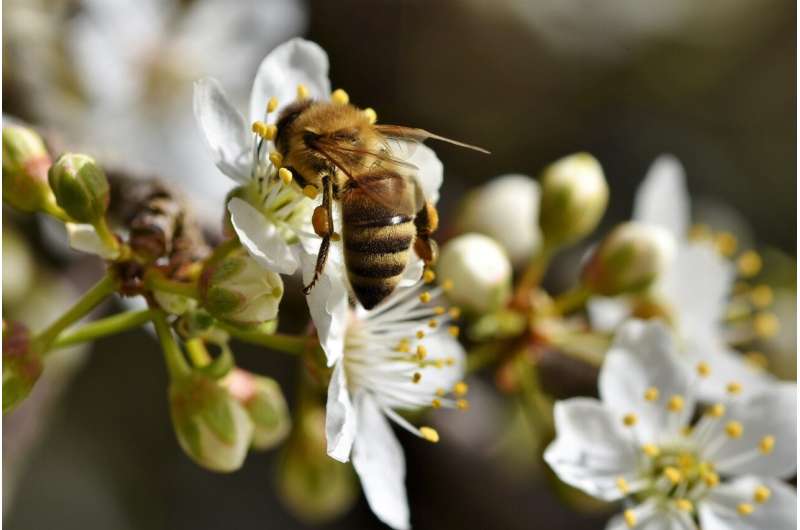This article has been reviewed according to Science X's editorial process and policies. Editors have highlighted the following attributes while ensuring the content's credibility:
fact-checked
peer-reviewed publication
trusted source
proofread
Changes in land use significantly affect larger bees, study shows

A new collaborative study has found that bees are increasingly under threat due to environmental degradation caused by changes in land use.
The researchers found changes such as land clearing and urban development, altered the availability of flowers in the landscape, significantly impacting bee populations, especially larger-bodied species.
Ecologists from The University of Western Australia, University of Canterbury in New Zealand and CSIRO, explored how the availability of floral energy resources in the landscape affected bee populations in 23 Banksia woodland fragments in Western Australia.
The researchers found that flowers in areas surrounding bushland were vital for the persistence of bees in remnant woodlands. The study is published in the Proceedings of the Royal Society B: Biological Sciences.
Dr. Juliana Pille Arnold, who led the study as a Ph.D. candidate at UWA, said the research underscored that floral energy resources in the surrounding landscape, known as "the matrix," played a pivotal role in supporting bee populations in fragmented habitats.
"We collected extensive data on bee populations, their interactions with plants, flower density in various land uses, and the energy content of nectar and pollen of the flowers they visit," Dr. Pille Arnold said.
"Bees depend entirely on nectar and pollen for nutrition and their ability to reproduce is greatly affected by the availability of food.
"We found that both small and large bees thrive in woodland remnants when there are more of their preferred flowers available in the surrounding landscape. However, larger bees, which need more energy, are particularly vulnerable to limitations of food resources.
"Natural habitats are being replaced at alarming rates, while only small fragments of the once continuous Banksia woodland remain scattered around the landscape. Therefore, management of the matrix surrounding woodlands is essential to connect remnant vegetation and help mitigate impacts on bees and other pollinators."
Study co-author, Professor Raphael Didham from UWA's School of Biological Sciences, said the findings showed conservation planning must incorporate the quality of the surrounding landscape to help protect bee populations in natural habitats.
"Our research showed that the surrounding landscape plays a crucial role in supporting bee populations, providing valuable insights for policymakers," Professor Didham said.
"It's clear that conservation efforts need to go beyond protecting isolated habitats and should consider the broader landscape context, with protecting remnant bushland, restoring natural habitats, and planting native plants in gardens, verges and parks all activities that could assist in supporting bees and their pollination services."
More information: Juliana Pille Arnold et al, Body-size-dependent effects of landscape-level resource energetics on pollinator abundance in woodland remnants, Proceedings of the Royal Society B: Biological Sciences (2024). DOI: 10.1098/rspb.2023.2771
Journal information: Proceedings of the Royal Society B
Provided by University of Western Australia





















